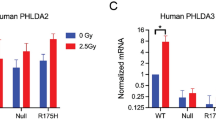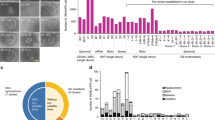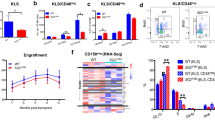Abstract
A model system was developed to allow investigation of the frequency at which clastogenic and/or mutagenic events occur in situ in a transplantable murine fibrosarcoma tumour (MC1A-C1) compared with in vitro culture. The marker selected for detecting these events was the X-linked hprt (hypoxanthine-guanine phosphoribosyltransferase) gene. We found that the hprt gene in MC1A-C1 was not suitable for this purpose, most likely because multiple active copies were present. To circumvent the problem, HPRT- [6-thioguanine (6-TG)-resistant] clones were isolated by inactivating all hprt genes with methylnitrosourea. Spontaneous revertants to hypoxanthine/aminopterin/thymidine resistance (HATR) were isolated and found to be approximately 1000 times more sensitive than the parental tumour to induction of 6-TGR mutants by cobalt-60 gamma-rays. This sensitivity is expected for a heterozygous marker, these revertants may therefore possess only one functional hprt locus but two or more active X chromosomes. A clone with a stable hprt gene was identified and a neo gene was introduced. The resulting cell line (MN-11) could be grown as a subcutaneous tumour in syngeneic C57BL/6 animals. The frequency of mutations arising in vivo in the marker hprt gene could be estimated by culturing explanted tumour cells in the presence of 6-TG, using G418 selection to distinguish tumour from host cells. The frequency of mutants in MN-11 cells grown as tumours was found to be 3.4-fold higher than in tissue culture for an equivalent period of time. These data provide the first direct evidence for the existence of mutagenic factors in a tumour environment that might contribute to tumour progression.
This is a preview of subscription content, access via your institution
Access options
Subscribe to this journal
Receive 24 print issues and online access
$259.00 per year
only $10.79 per issue
Buy this article
- Purchase on Springer Link
- Instant access to full article PDF
Prices may be subject to local taxes which are calculated during checkout
Similar content being viewed by others
Author information
Authors and Affiliations
Rights and permissions
About this article
Cite this article
Wilkinson, D., Sandhu, J., Breneman, J. et al. Hprt mutants in a transplantable murine tumour arise more frequently in vivo than in vitro. Br J Cancer 72, 1234–1240 (1995). https://doi.org/10.1038/bjc.1995.492
Issue Date:
DOI: https://doi.org/10.1038/bjc.1995.492
This article is cited by
-
Neutrophils: important contributors to tumor progression and metastasis
Cancer and Metastasis Reviews (2015)
-
Evolutionary dynamics of carcinogenesis and why targeted therapy does not work
Nature Reviews Cancer (2012)
-
Expression of Interleukin-8 Promotes Neutrophil Infiltration and Genetic Instability in Mutatect Tumors
Neoplasia (2000)



